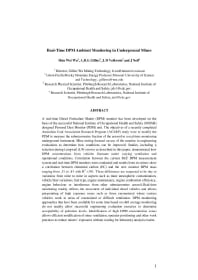Mining Publication: Real-Time DPM Ambient Monitoring in Underground Mines
Original creation date: November 2009
Authors: HW Wu, AD Gillies, JC Volkwein, JD Noll
NIOSHTIC2 Number: 20036279
Proceedings of the Ninth International Mine Ventilation Congress, New Delhi, India, November 10-13, 2009. Panigrahi DC, ed., New Delhi, India: Oxford & IBH Publishing Co. Pvt. Ltd., 2009; :821-830
A real-time Diesel Particulate Matter (DPM) monitor has been developed on the basis of the successful National Institute of Occupational Health and Safety (NIOSH) designed Personal Dust Monitor (PDM) unit. The objectives of a recently completed Australian Coal Association Research Program (ACARP) study were to modify the PDM to measure the submicrometre fraction of the aerosol in a real-time monitoring underground instrument. Mine testing focused on use of the monitor in engineering evaluations to determine how conditions can be improved. Studies, including a selection during Longwall (LW) moves as described in this paper, demonstrated how DPM concentrations from vehicles fluctuate under varying ventilation and operational conditions. Correlation between the current SKC DPM measurement system and real-time DPM monitors were conducted and results from six mines show a correlation between elemental carbon (EC) and the new monitor DPM mass ranging from .51 to .81 with R2 >.90. These differences are suspected to be due to variations from mine to mine in aspects such as mine atmospheric contamination, vehicle fleet variations, fuel type, engine maintenance, engine combustion efficiency, engine behaviour or interference from other submicrometre aerosol. Real-time monitoring readily reflects the movement of individual diesel vehicles and allows pin-pointing of high exposure zones such as those encountered where various vehicles work in areas of constrained or difficult ventilation. DPM monitoring approaches that have been available for some time based on shift average monitoring do not readily allow successful engineering evaluation exercises to determine acceptability of pollution levels. Identification of high DPM concentration zones allows efficient modification of mine ventilation, operator positioning and other work practices to reduce miners' exposures without waiting for laboratory analysis results.

NIOSHTIC2 Number: 20036279
Proceedings of the Ninth International Mine Ventilation Congress, New Delhi, India, November 10-13, 2009. Panigrahi DC, ed., New Delhi, India: Oxford & IBH Publishing Co. Pvt. Ltd., 2009; :821-830
- Diesel Exhaust Aerosol, Review of Measurement Technology
- Differential Pressure as a Measure of Particulate Matter Emissions from Diesel Engines
- Evaluation of a Wearable Monitor for Measuring Real-time Diesel Particulate Matter Concentrations in Several Underground Mines
- Field Evaluation of Diesel Particulate Matter Using Portable Elemental Carbon Monitors
- Instrumentation for Diesel Particulate Matter Emissions Research
- Real-time Diesel Particulate Monitor for Underground Mines
- Role of Lubrication Oil in Particulate Emissions from a Hydrogen-Powered Internal Combustion Engine
- Sampling Results of the Improved SKC� Diesel Particulate Matter Cassette
- Stress Measurements for Safety Decisions in Longwall Coal
- Underground Mine Diesel Particulate Monitor Network